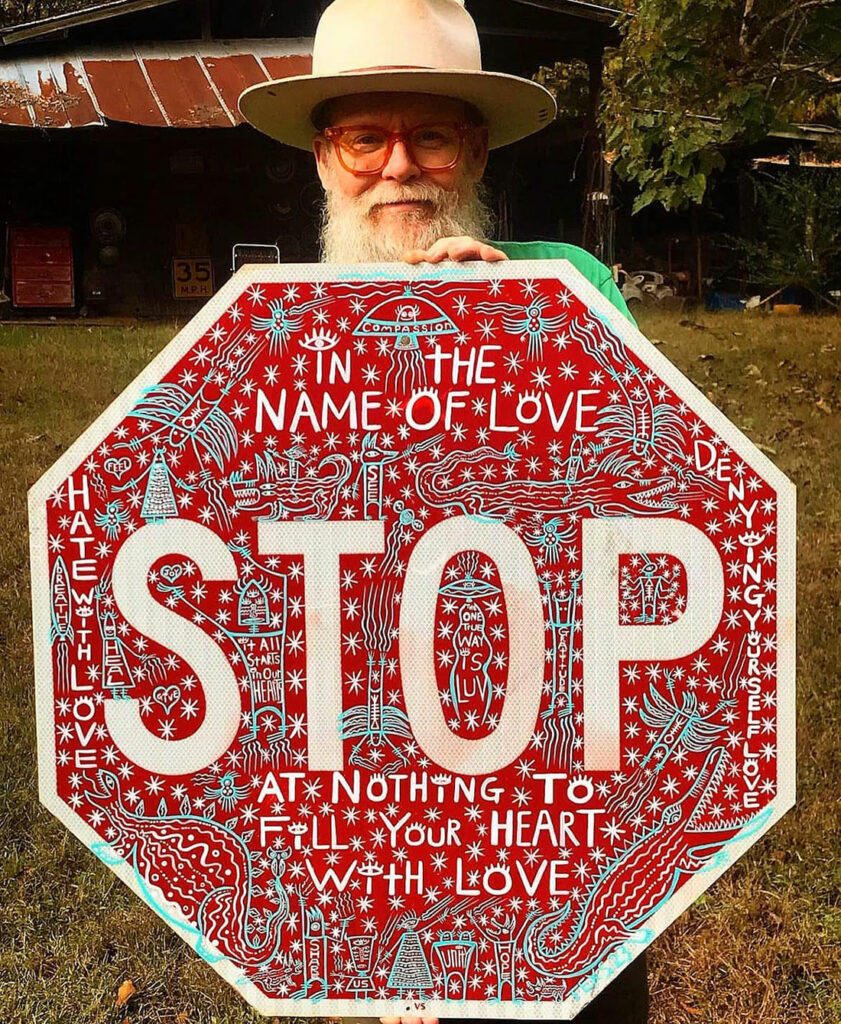With a passion for turning junk into joy, self-taught artist Tex Crawford’s curious and creative spirit has led him to transform repurposed materials into works of art for over two decades. His cut tin creations vibrate with bright colors, often detailed with dizzying petroglyph-like illustrations. While his preferred medium is reclaimed roofing tin, he also creates paintings and sculptural assemblages constructed from found objects. His vibrant and fantastical world is one in which wildlife, dinosaurs, flying saucers and creatures of the imagination co-exist.
For Crawford, making artwork has often been about finding a balance between the ups and downs of the human experience. While typically uplifting and exuberant, his artwork recognizes that it’s the trials and tribulations of life that lead to a deeper appreciation for finding happiness or beauty.
“When I was six I found my mother, who had committed suicide, and I think my imagination broke wide open,” says Crawford. “Looking back now, I think doodling and drawing really helped me to cope with her loss. I created an imaginary world through my art that for many years I felt safe inside of.”
Though creative from a young age, it wasn’t until the early 2000s that he began professionally pivoting towards visual art. He and his late wife had just moved further out to Crawford, where they rented a small cottage that stood behind Lamar Wood’s Brick House Gallery. As he passed a giant pile of roofing tin on his daily walk to the mailbox, he began visualizing the silhouettes of giant creatures across the long sheets of tin. With Wood’s blessing, he cut the tin to create his first “Textopians,” totem-like characters that towered 15 feet tall.

Wood encouraged him to create additional pieces for an upcoming exhibition. Before long, Crawford found a new rhythm of balancing his artistic practice with his engineering work for various sound companies, the Local IATSE 824 union, and downtown venues such as Tasty World and Last Call over the next handful of years. With time, he was participating in enough art festivals and completing enough commissions to sustain himself as a full-time artist.
Drawn in by the city’s flourishing scene, Crawford first moved to Athens in 1991 with the intentions of pursuing a career in the music industry and briefly owned a recording studio. While recording and producing the American Dream album for Dubconscious, he met a saxophone player named George Davidson who was sent to the studio to record a few horn parts. To Crawford’s surprise, Davidson turned out to be the artist who had made several linocut prints of blues artists—simply signed “GD”—in Crawford’s collection.
“He really taught me a lot about art and finding my unique voice, as well as helping me to understand the cyclical journey of being an artist,” says Crawford. “[He] shared with me insights and wisdom that he had spent a lifetime gathering through his own career and creative path. Without George’s friendship and guidance, I don’t think I would’ve had the understanding and skills to have stayed the path this long.”
Carrying the torch for Georgia’s rich history of self-taught artists, Crawford also cites R.A. Miller and Howard Finster as significant influences on his style. Miller is best remembered for the hundreds of whirligigs and simple, sharp-edged metal cutouts that he covered his lawn with and would sell by the side of the road. Finster, a prolific preacher-turned-artist who churned out tens of thousands of works, developed Paradise Garden—a visionary art environment full of sculptures, mosaics, paintings and all sorts of exquisitely strange structures—over the course of 30-plus years. Both artists relied heavily on repurposed materials and, like Crawford, often used their works as vehicles to relay inspirational or spiritual messages.
“I’ve always been drawn to the fact that a lot of materials I use had a purpose and life before I interact with them to create an artifact,” says Crawford. “I mean, some of the roofing tin I’ve used sheltered livestock through storms and winter, and now it has been transformed into a creature that hangs on someone’s wall, hopefully giving them some enjoyment and happiness, and not rotting in a landfill. It’s not a new concept by any means. However, the message comes through loud and clear with a little ingenuity and imagination. A lot of the materials we’re so quick to toss into the landfill could be repurposed into all types of solutions. When I look at a pile of ‘junk,’ I see opportunity and possibilities.”

Like the creature bearing the message “Sow Seeds of Love” on this week’s cover of Flagpole, Crawford’s work is known to amplify themes of love, joy and hope. Those in his online orbit, and those lucky enough to cross paths in person, are regularly greeted with optimistic messages that radiate with positive energy.
It feels cosmically cruel, then, for Crawford’s life to have been irrevocably changed when his wife and best friend, Donna Marie Crawford, died unexpectedly in February earlier this year. Friends quickly rallied with a GoFundMe campaign to support him as he traveled the rocky road ahead.
“I feel most fortunate for all the love and support I have received from my family, friends and this wonderful community as a whole,” says Crawford. “There aren’t really words that can even come close to expressing the gratitude I feel in my heart from all the acts of kindness and compassion that so many folks, friends and family have shared with me while I’ve been grieving and dealing with the PTSD I’m suffering from because of the sudden nature of my sweet Donna’s passing.”
Despite his devastating loss, Crawford has slowly begun returning to his studio to create artwork. At first, he’d experience headaches, nausea, feelings of guilt and even panic attacks. But with the guidance of a therapist and his support network, he’s begun taking the time to process his emotions and use art as a tool for coping through tragedy. He notes that Your Brain on Art: How the Arts Transform Us, a New York Times Bestseller by Susan Magsamen and Ivy Ross, was particularly helpful in presenting research on how art-making can dramatically reduce the effects of Post-Traumatic Stress Disorder.
“I think I realized a while back that it’s going to be a long journey of healing that so many other folks unfortunately are having to make or will have to make down the road,” says Crawford. “I was blessed to have found my soulmate, and the cost of true love if we outlive our dearest is to understand in a deep way true loss. However, I’m committed to continuing on Donna’s legacy of love. She taught me how to be grateful for every new day, and to stop and notice the beauty and wonder that surrounds us all. I really miss the way she would look at me with that light in her eyes as if there wasn’t anything I couldn’t accomplish!”
Crawford recently designed the theme artwork for FoxSaid Fest, a new folk-forward music and arts festival that will be held this weekend on Saturday, July 27 at the Athens Cotton Press (see story on p. 7). In addition to an artist market, the festival’s programming emphasizes participatory art experiences led by professional artists. Crawford plans to bring several different sized creatures cut from reclaimed Baltic birch, including a fox, for attendees to paint and take home as mementos.
Looking towards the future, Crawford is steadily creating new artwork in anticipation of multiple notable festivals across the Southeast. On Sept. 21–22 in Summerville he’ll return to Finster Fest, an annual festival with a sizable artist market and live music performances that take over the grounds of Paradise Garden. On Feb. 21–23 in Pittsboro, NC, Crawford will participate in the Fearrington Folk Art Show, another long-running staple of the folk art world that’s dedicated to celebrating self-taught artists. To keep up with Crawford, visit instagram.com/tex_s_crawford or texcrawfordcreations.com.
Like what you just read? Support Flagpole by making a donation today. Every dollar you give helps fund our ongoing mission to provide Athens with quality, independent journalism.









